Paragon Board Selection and Pathing
Last Updated:August 3, 2024|Changelog
Paragon Boards selection adds a lot of depth to endgame progression, but that depth also brings a level of complexity that may seem daunting for many players. In this guide, we demystify the process of setting up your Paragon Boards to make it simpler, faster, and more efficient, so you can quickly get back to slaying monsters while still feeling confident in your choices. As with every strategy, there are going to be exceptions, but using this guide as a general rule of thumb should make planning out your boards far easier and lead to better choices.
To learn the basics about Paragon Boards check out our Paragon Boards guide.
Choosing your Boards
The first step is to decide which Boards you want to build into. Each class has 8 Boards (plus a Starting Board), but you won't have enough points to invest in them all, so we need a process to determine the best choices for your build.
Determine The Best Nodes
The best Boards are going to be determined by how well the nodes on them fit your particular build. There are several different types of nodes to consider and they aren't all weighted equally, so understanding what makes a node valuable and then being able to compare it against others is key.
Legendary Nodes
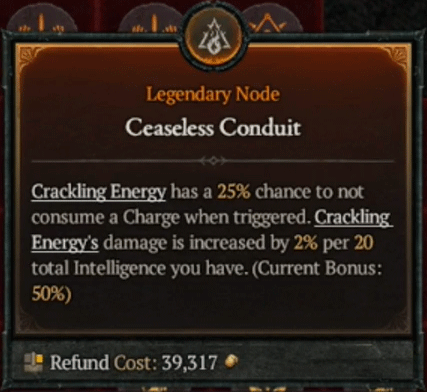
These are the flashy orange nodes that the entire Board is designed around and named after. Because of this, many players assume they are also the most important nodes on the Board, and this is often the case. However, the other options we cover below can be just as important or more, so don't just assume that the Legendary is all that matters! Consider all of the important nodes on a Board before committing. If two Legendary Nodes are similar in power, a good Rare node or well-placed Glyph socket may be the difference.
One important factor to bear in mind is that offensive Legendary nodes provide multiplicative damage, which makes them even more powerful than they may seem. If it fits really well with your build, then it should be factored heavily in your decision to use the board.
Rare Nodes
Rare Nodes offer substantially greater and more diverse stats than other nodes on the board, making them especially powerful.
In addition, you can unlock a Bonus when you reach a certain Attribute threshold. This threshold increases with each connected Paragon Board, making it more difficult to get that bonus.
Planning boards with particularly powerful Rare Nodes early on will ensure that you get the bonuses for them. Alternatively, pacing Rare Nodes with stat requirements that you have a lot of later in your board can allow you to get more total bonuses.
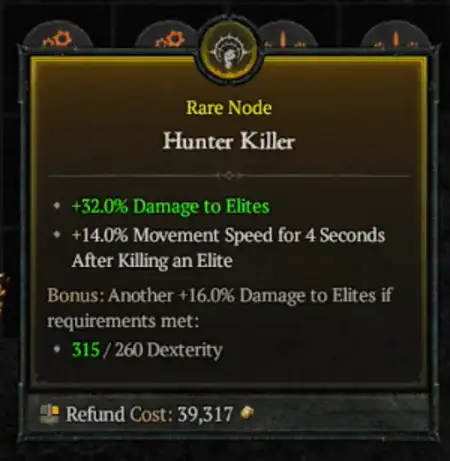
Rare offensive nodes are typically very powerful early game when you lack additive damage but can fall off later when other sources of additive damage come online. Other nodes, like increased health, maintain their relative power since Increased Health is a difficult stat to find and it scales with any additive health you acquire from other sources.
Magic Nodes
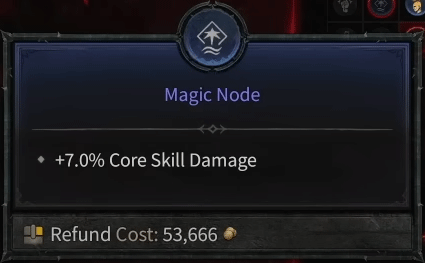
Generally weaker than Rare nodes, these can still provide a substantial boost to your build. Their biggest strength lies in the fact that you can invest into several with the same stat, so if a cluster has a good stat you can end up with quite a lot of it with minimal investment. Magic nodes follow the general theme of their Rare parent, so if the Rare is good for your build, the Magic is likely to follow.
Still, there are exceptions, and just because a stat is good for you doesn't mean there isn't a better alternative. Example: A node with generic 5% damage is good for just about any build, but the damage is additive with other sources. At late game you probably already have a lot of additive damage. If another node offers 5% Attack Speed and your build benefits from it, the relative power increase for your build may be higher with the Attack Speed node because it's harder to find, so you may have a lot less of it.
Hypothetically, If you didn't have any additional attack speed at the time you took this node, you would attack exactly 5% faster than before you took it. Alternatively, if you took the 5% damage node but already had 100% additive damage, you would only deal 2.5% more damage than before you took the node.
Glyph Sockets
Glyph sockets are the most complex of all the nodes and will require the most thought and planning to get the most out of. Glyphs are acquired as drops and can be placed in these special sockets. Each Glyph has an effect that either improves the power of nearby Rare or Magic nodes or draws power from nearby nodes to grant a special effect. Make sure to read the description carefully to understand how to maximize these benefits
Once you understand the benefits, the biggest factor for your board is determining what sockets will be most beneficial to the Glyphs you want to use. For example, a Glyph that provides a bonus to Rare nodes within range should be used in a socket that has the most impactful Rare nodes nearby so that you get the most benefit. A Glyph that gets stronger from selecting nodes with a certain attribute will want to be in a socket that has the most density for that attribute within range.
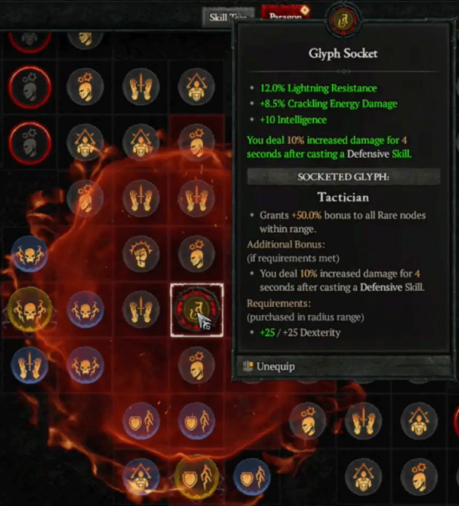
Additionally, each Glyph needs a certain amount of a single attribute from the nodes within its radius to unlock a secondary bonus (Note that this requirement is different from the one seen on Rare nodes like the one to the right. The picture above it shows an example of a Glyph with a requirement of 25 Dexterity).
You can reach this bonus through any combination of Rare, Magic, and Common nodes. When trying to reach a Glyph's requirements, start by looking at the Rare nodes in range of the socket that you already want to invest in and see if they have an attribute benefit that matches what you're looking for. Rares provide the largest attribute gain (+10), so if you can hit on this there's a good chance the socket will be a solid choice.
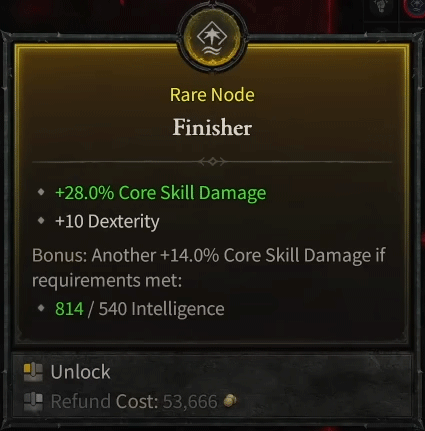
Next, look to see if there are any Magic nodes that have that attribute. These offer 2 more points than Common nodes. There are only two of these for any given attribute so it won't lower the number of nodes you need (meaning the additional +4 gained from two Magic nodes will never prevent you from needing another node since you still need 1 more of that attribute), but they still offer more value than Common nodes of the same attribute. For now, only take these if you were already taking them for pathing.
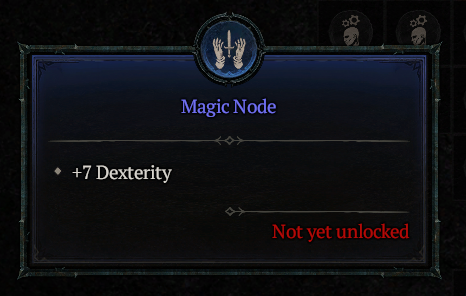
Now see how many Common nodes have that attribute and are already along a path you might choose to take. This would be nodes that lead to other parts of the board that either have nodes you want or lead to an exit point. Finally, look at Common and Magic nodes that don't lead to paths but that you could reasonably take with minimal investment if needed. Prioritize the shortest path. If they are equal, prioritize Magic over Common for the extra attributes. Remember, the fewer additional nodes you need to take beyond your natural pathing, the more points you can spend on higher impact nodes.
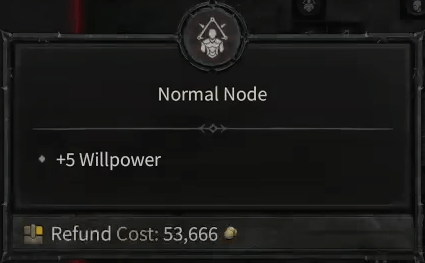
This process determines how efficiently you can reach your Glyph Bonuses. However, there are often times when taking more than the required attribute for a Glyph is worthwhile. For example, many Glyphs provide a stat based on how much of a given attribute is within its range. Example: The Werewolf Glyph states 'For every 5 Willpower purchase within range, you deal x% increased damage while in Werewolf form'. If you were playing a Werewolf build and determined that this stat is important for you, you should consider investing beyond the Glyph's 40 Willpower requirement.
Once you've analyzed all of the potential sockets you can now determine which are best for the Glyphs you want to use. Plan to place them in the sockets that have the best access to the attribute they require without spending additional points on nodes you otherwise wouldn't take. Ultimately you may need to be flexible and make some compromises, but starting from this ideal state will give you a good foundation for deciding which boards work best for your build.
Making Your Choices
Since you won't be able to invest in every board, you need to choose the best and leave the rest. How you choose those is going to vary somewhat from build to build, but here's some general rules to follow:
- Make a priority list of all eight Boards. Pick the 5-6 best and order them from most desirable to least. At this stage you won't know exactly how many Boards you can fit so plan for extra and then if needed cut them down later as you choose your path.
- If a Legendary node is especially powerful and synergistic for your build, you're almost always going to want to invest in it and it should probably be high on your priority list. The Legendary node dictates the general theme of the board so if it's that good, chances are the rest of the nodes are as well.
- Some Legendary nodes might not be best for your final setup but are great at early endgame before you've acquired all of your gear. In these circumstances, it may be best to set up two versions of your Paragon Board: one for early endgame and one for later when your build is fully online.
- Don't just look at the Rare nodes, also consider the Magic nodes surrounding it. Two Rares might have similar value, but the Magic nodes could put one over the top. Think of Rare and Magic Nodes as a single cluster, and evaluate the cluster as a whole.
- Not every cluster has to be good in order for a Board to be worth it. Remember, you don't need to invest in every cluster, and not investing in some might save you enough points to add another Board.
- Plan for the Glyphs you want to use and look for the sockets that best fit them. Try to find at least one good socket for every Glyph you want. The more sockets that work for each Glyph the better, as it will give you added flexibility when choosing your path.
- Consider the path you need to take to pick up the nodes you want. We talk about this much more in the next section, but even before optimizing your path you still need to factor in how far away nodes are from each other when determining which Boards you want. If two Boards seem like they have similar value, count the number of points you need to invest in order to make each Board work. If one requires fewer points, that might be enough to tip the scale in its favor by allowing you to invest more in other areas.
- Don't forget defense! Many players over value offensive nodes and ultimately end up too squishy. Make sure your selected Boards have a good balance of both offense and defense.
Optimizing Your Path
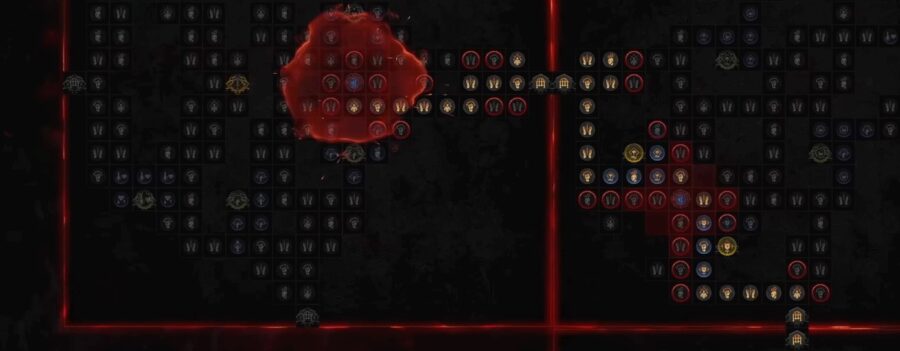
Now that you've selected the Boards you want to use, it's time to plan out your path through the connected Boards. This step is all about maximizing efficiency; we want to get the most possible desirable nodes into our board within the allotted points while also prioritizing the very best ones. To accomplish this, we need to employ several strategies. We do this for every board, starting from highest priority to lowest, until we've exhausted all of our points and cannot find a more optimal path that maximizes the amount of desired nodes we can pick up.
Determine The Shortest Route
The first thing we want to accomplish is finding the shortest route through each of our boards that still picks up all of the major nodes we want. This is usually accomplished by taking the most direct path to each node, starting with the node closest to the entrance to the board first and ending with the node closest to the exit. Nodes in between these two can be trickier, but you can generally move to the next closest until you reach the exit. Due to the way some boards are set up, it may make more sense to branch out to access a valuable node or cluster and then go back to a previous one to continue on the path.
Speaking of the exit, when possible always choose the one that is closest to a node that you can end with. This will save you several points that you can use elsewhere.
Rotating Boards
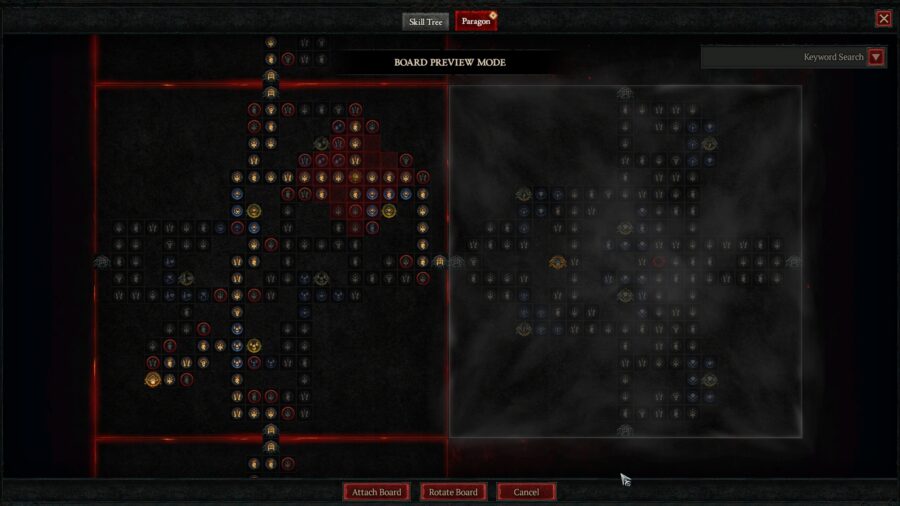
Boards have 4 different connection points, and the orientation of each Board is not static. They can be rotated 90 degrees, which allows you to connect a Board from any point. Use this to your advantage to create the shortest possible path and avoid wasting points. Having the ability to rotate your boards also means you don't have to worry about which connection point you end at, since the next Board can be reoriented to accommodate the connection point. The only exception to this is if the ending point on the Board would lead you back into a previously established board, preventing a connection to a new board.
Don't Deviate!
If you find yourself lacking in a particular attribute, don't deviate from your chosen path to pick up extra common nodes of that resource. Common nodes are very low value, so picking up more than you need lowers the number of high value nodes you can acquire.
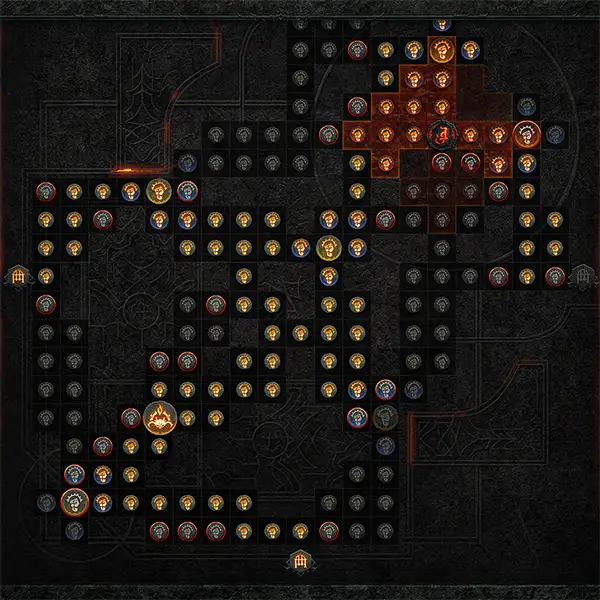
There is almost never any value in branching out from your chosen path to pick up common nodes (Reaching Glyph bonus requirements is a notable exception). Instead, follow the strategy below to improve your attribute distribution while still maximizing your points.
Optimizing Your Attribute Distribution
Although we're trying to get to the high value Nodes as efficiently as possible, there are many times where two paths are equally as fast, but also offer different attributes. This most often happens when we need to change direction but can do so from multiple points.
These decision points make for excellent opportunities to pick up attributes that you need for your bonuses on Rare nodes. Keep track of how many of each attribute you need and how many you pick up naturally from pathing through the Boards, then use the decision points to fill in where you need extra. Don't forget, your gear and Altars of Lilith will also offer attributes, so it's not necessary to get all of them from the board.
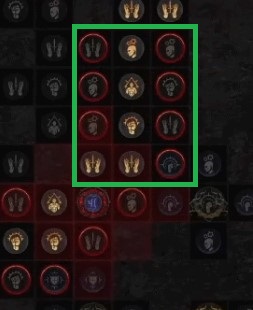
Advanced Strategies
While the above sections will lead you to an optimized setup, there are still some strategies that advanced players can employ to get even more efficiency out of their board.
Glyphs
There are some important factors to consider with Glyphs:
- They must be found
- They have rarities
- They must be leveled to reach their maximum power.
When you reach the endgame you won't have the Glyphs you need and must hunt for them. Once you have them, it's time to level them in Nightmare Dungeons to reach their full potential.
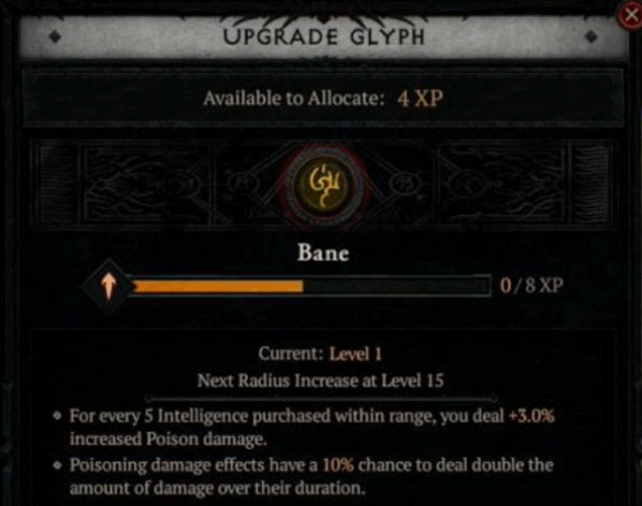
Due to these factors, building around a socket early likely decreases your power when compared to investing in other nodes. Lower level and rarity sockets also have a smaller radius of Nodes that they affect, making it even harder to benefit from them. Typically, you're better off waiting to invest heavily into sockets until they have been sufficiently leveled up. This could mean avoiding sockets until later and respeccing into them when the Glyphs are ready. Doing so will open up those points to use on more impactful nodes, which in turn will make it easier to handle Nightmare Dungeons to level your Glyphs.
Far Away Valuable Nodes
Sometimes a Board will have multiple valuable nodes on it that are very far away from each other, and the stuff in between provides little additional value. In these cases, it may be better to jump into a Board multiple times.
In this scenario, we would enter a Board near a valuable node and then immediately move on to the nearest exit node. We would then set up the rest of our boards in a way that could circle back to the other side of the Board with the far away nodes. This only works if we have enough additional boards to invest in and naturally want the points in them. It can take a lot of planning to pull off, but success can mean saving several points to spend in more valuable areas.
Respeccing
Glyphs aren't the only reason to consider respeccing your Paragon Boards. Certain stats become more powerful over time while others become weaker. We touched on this a bit with additive damage, but the concept applies to many areas of the game. Example: you want to make a Poison build, but to get the most out of Poison you need a Unique or a Legendary power. Before acquiring the item your build would be better off with more generic sources of damage. You could invest early in Poison nodes on the Paragon Board, or you could invest in the more generic damage options and respec into poison once you have the item you need.
Clearly, respeccing will be the more efficient option because it will increase your damage early on, which improves your clear speed and increases your drops. This has the knock on effect of increasing the chance that you find the item you need faster, allowing you to respec and take full advantage of the Poison nodes faster. Following this strategy will require some pre planning and a gold investment, but if you're willing to spend the time and money, it's worth the effort.
Video Guide
Summary
- Paragon Board selection requires careful planning and a solid strategy to get the most out of them
- Players must consider Legendary, Rare, and Magic Nodes, as well as Glyphs, when determining which Boards to take.
- Glyphs require another level of planning because they fit into Glyph Sockets. Some Sockets will be better than others for any given Glyph.
- Optimize your path through the Paragon Boards you choose to save you valuable points that can then be spent on more impactful nodes.
- Be careful not to over prioritize Glyphs too early. They need to be found and leveled up before they reach their true potential.
- Respeccing can be a powerful tool for maximizing both the early and late endgame. Don't fall into the trap of using a late game setup too early and then being underpowered when another setup would be better!
Credits
Written by McFluffin
Reviewed by IBoilerUp & ehtoka